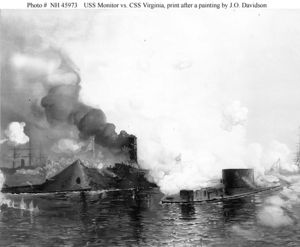Battle of Hampton Roads
Fought on March 8-9, 1862, while tactically a draw or a slight Confederate win, the Battle of Hampton Roads was among the most significant naval battles of history. [1] While some battles were notable because one side introduced a "silver bullet" advanced technology, obsoleting the other side's systems, this is unique in that two successive silver bullets fought on two successive days. The ironclad CSS Virginia, often called the Merrimac after the abandoned Union ship from which she was adapted, was the first armored steamship to enter combat, far more advanced than anything else afloat — for a day. She was then met by the even more advanced USS Monitor.
Virginia was still based on a conventional broadside design, with rows of 8" cannon in fixed mounts, six on each side, with unconventionally sloped sides [2] covered with iron plate armor. While stealth technology was more than a century in the future, she had an eerie resemblance to the prototype USS Sea Shadow After sinking the wooden USS Cumberland and damaging the USS Congress, Virginia returned to dock. While there actually had been internal damage from the concussive effect of Union hits, it had appeared as she had shrugged away the heaviest gunfire.
On the next day, however, an even stranger-looking vessel, USS Monitor, came to meet her. Derisively called a "cheesebox on a raft", Monitor, even lower in the water than Virginia, was a leap forward in design. The power of naval guns increases exponentially with their shell diameter, or caliber. While Monitor had only two guns, they were 11", and mounted in a revolving turret, so she could aim them at any relative bearing to her opponent, not only in the conventional parallel course for broadside weapons.
References
- ↑ Joel K. Bourne, Jr. (2006), "Iron vs. Oak"When the currents of history and technology collided off Hampton, Virginia, in March 1862, naval warfare changed forever.", National Geographic
- ↑ Sloped armor is considerably more effective than vertical armor, a technology lost in tanks until after the Second World War
